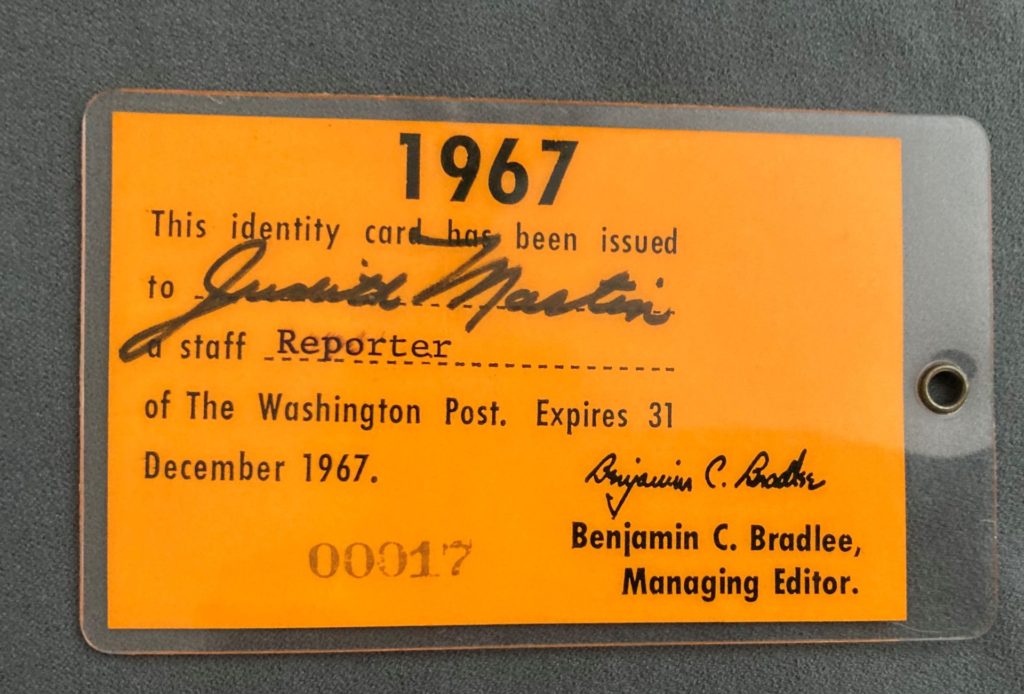The Whole Spiel
Judith Martin, a Reporter in a Party Dress
March 3, 2021
Judith Martin is a journalist who was a writer for the women’s section of the Washington Post, an early version of what is now known as the Style Section. She started writing an advice column for the Washington Post in 1978 and continues to write about etiquette today in online articles, books and more. Judith Martin was one of the women reporters for the women’s section under Marie Sauer.

Judith Martin’s collection of press passes, including her White House Press Passes will be featured in the museum.
Big stories such as, The March on Washington, MLK’s funeral, and even the war on Vietnam would now be part of mainstream journalism, but at the time were being reported in the women’s section. In fact, the first time the Washington Post reports about the War in Vietnam it was in the women’s section. In an oral history with CJM, Judith remarked that at a White House party President Johnson told her that he may have started WWIII, when she asked how so, he responded that he had just bombed North Vietnam for the first time. Judith took this information back to the paper and shared it with a national editor who turned to another and said “If that’s true, we ought to put a reporter on it.” She said “Never mind,” and then they ran it in the women’s section.
As a young reporter, just out of Wellesley, Judith reported stories that weren’t always picked up by the other sections in The Post. She and her fellow reporters would expand on stories for their 8-page spread in order to add color and paint a fuller, more illustrious picture. Before heading out to her regular beat, embassy parties, Judith would stop by the foreign desk and ask for an update of what was going on in the world. She would then head to an embassy party, and because she was a woman, the sexism of the time worked in her favor. Sources who had been avoiding reporter’s questions during the day wouldn’t think twice before spilling the information to a seemingly unassuming reporter.
“Inevitably, such a rich source would call the managing editor the next day, outraged at seeing his own words in print, to scream, “How was I to know that girl was a reporter?”
Yes, he would have to admit, I had identified myself as being a reporter from The Washington Post. Yes, he had noticed that I took notes while he talked. But how could anyone be expected to understand that a woman wearing a party dress was a working reporter?”
-Judith Martin, In defense of ‘women’s pages’, Washington Post 2014

Judith Martin’s ID card for The Washington Post authorized by influential editor, Ben Bradlee.
This was a regular occurrence in the women’s section. Often the reporters would pick up information from the party circuit, that wouldn’t have been reported or mentioned elsewhere. These stories often ruffled feathers and the editors would get an influx of calls. Judith remarks about Ben Bradlee- “When he’d see me in the hall, he’d say, ‘Why is it always you?’ and I’d think, ‘That’s a fair question.’” The women’s section was one of the only sections that seriously reported on the feminist revolution of the 60s and 70s, including the women’s strike. Few people suspected these women of being anything more than party goers, but they were reporting on serious news and surrounded their stories.
Early reporters like Judith paved a path for journalism today and the women’s sections of the past provided many women with opportunities to enter the field. With editors like Miss Sauer at the helm these women found themselves working in hard hitting journalism. After all, the woman in the party dress is just as powerful as the one in the pantsuit.
